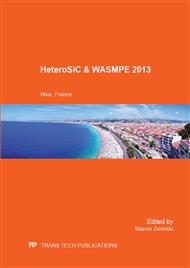[1]
S. E. Saddow, A. Agarwal, Advances in Siliocn Carbide Processing and Applications, first ed., Artech House, Boston, (2004).
Google Scholar
[2]
X. Shen, S. T. Pantelides, Identification of a major cause of endemically poor mobilities in SiC/SiO2structures, Appl. Phys. Lett., 98 (2011) 053507-053507-3.
DOI: 10.1063/1.3553786
Google Scholar
[3]
F. Devynck, A. Pasquarello, Semiconductor defects at the interface, Physica B: Condensed Matt., 401 (2007) 556-559.
DOI: 10.1016/j.physb.2007.09.020
Google Scholar
[4]
K. Shenai, Switching Megawatts with Power Transistors, Electochemical Society Interface, (2013) 47-53.
Google Scholar
[5]
X. Zhu, H.D. Lee,T. Feng, A.C. Ahyi, D. Mastrogiovanni, A. Wan, E. Garfunkel, J.R. Williams, T. Gustafsson, J.R. Williams, L.C. Feldman, Structure and stoichiometry of (0001) 4H–SiC/oxide interface, Appl. Phys. Lett., 97 (2010) 071908-071908-3.
DOI: 10.1063/1.3481672
Google Scholar
[6]
S. Potbhare, N. Goldsman, G. Pennington, A. Lelis, J.M. McGarrity, Numerical and experimental characterization of 4H silicon carbide lateral metal-oxide-semiconductor field-effect transistor, J. Appl. Phys., 100 (2006) 044516-044516-8.
DOI: 10.1063/1.2335967
Google Scholar
[7]
G. Y. Chung, C. C. Tin, J. R. Williams, K. McDonald, R. K. Chanana, Robert A. Weller, S. T. Pantelides, Leonard C. Feldman, Member,O. W. Holland, M. K. Das, John W. Palmour, Improved inversion channel mobility for 4H-SiC MOSFETs following high temperature anneals in nitric oxide, IEEE Electron Device Lett., 22 (2001).
DOI: 10.1109/55.915604
Google Scholar
[8]
J. Senzaki, K. Kojima, S. Harada, R. Kosugi, S. Senzaki, K. Fukuda, Excellent effects of hydrogen postoxidation annealing on inversion channel mobility of 4H-SiC MOSFET fabricated on (11 2 0) face, IEEE Electron Dev. Lett., 23 (2002) 13-15.
DOI: 10.1109/55.974797
Google Scholar
[9]
J. Welser, J. L. Hoyt, J. F. Gibbons, Electron mobility enhancement in strained-Si n-type metal-oxide-semiconductor field-effect transistors, IEEE Electron Device Lett., 15 (1994) 100-102.
DOI: 10.1109/55.285389
Google Scholar
[10]
D. Okamato, H. Yano, T. Hatayama, and T. Fuyuki, Improved inversion channel mobility in 4H-SiC MOSFETs on Si face utilizing phosphorus-doped gate oxide, IEEE Electron Device Lett., 31 (2010) 710-712.
DOI: 10.1109/led.2010.2047239
Google Scholar
[11]
Y. K. Sharma, A. C. Ahyi, T. Issacs-Smith, X. Shen, S. T. Pantelides, X. Zhu, J. Rozen, L.C. Feldman, Y. Xu, E. Garfunkel, J.R. Williams, Phosphorous passivation of the SiO2/4H-SiC interface, Solid-State Electron., 68 (2012) 103-107.
DOI: 10.1016/j.sse.2011.10.030
Google Scholar
[12]
B. R. Tuttle, S. Dhar, S.H. Ryu, X. Zhu, J. R. Williams, L. C. Feldman, S. T. Pantelides, transistors, Appl. Phys., 109 (2011) 023702-023702-6.
Google Scholar
[13]
W. Kern and J. L. Vossen, Thin Film Processes, first ed., Academic Press, New York, (1991).
Google Scholar
[14]
Aivars J. Lelis, Daniel B. Habersat, Ronald Green, and Neil Goldsman, Temperature-Dependence of SiC MOSFET Threshold-Voltage Instability, Mater. Sci. Forum, 600-603 (2008) 807-810.
DOI: 10.4028/www.scientific.net/msf.600-603.807
Google Scholar
[15]
J. M. Eldridge, R. B. Laibowitz, P. Balk, Phosphosilicate glass stabilization of FET devices, Proceedings of the IEEE, 57 (1969) 1558-1563.
DOI: 10.1109/proc.1969.7336
Google Scholar


